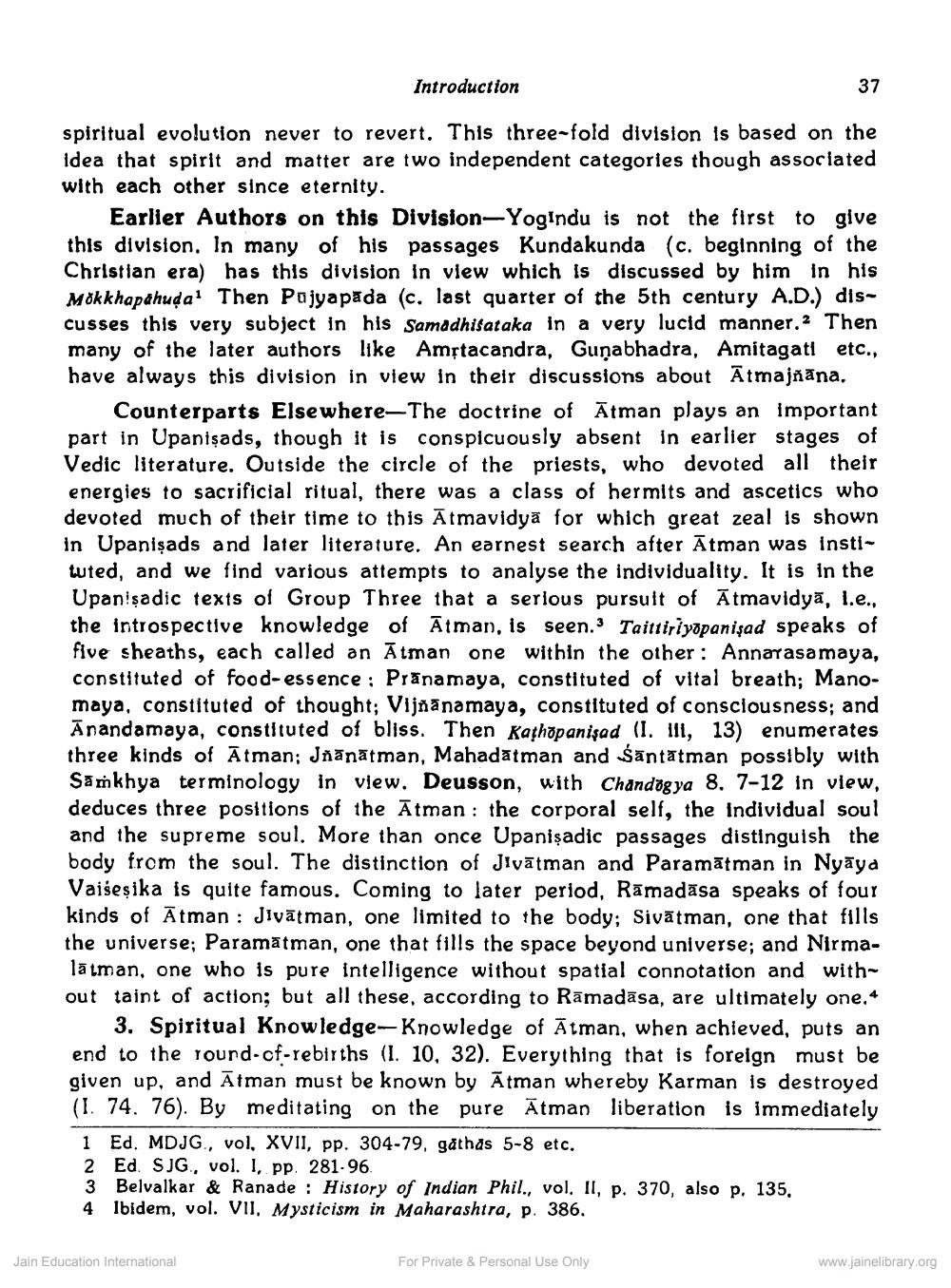________________
Introduction
spiritual evolution never to revert. This three-fold division is based on the idea that spirit and matter are two independent categories though associated with each other since eternity.
Earlier Authors on this Division-Yogindu is not the first to give this division. In many of his passages Kundakunda (c. beginning of the Christian era) has this division in view which is discussed by him in his Mikkhapahuda Then Pajyapada (c. last quarter of the 5th century A.D.) discusses this very subject in his Samadhitataka in a very lucid manner. Then, many of the later authors like Amṛtacandra, Gunabhadra, Amitagati etc., have always this division in view in their discussions about Atmajnana.
Counterparts Elsewhere-The doctrine of Atman plays an important part in Upanisads, though it is conspicuously absent in earlier stages of Vedic literature. Outside the circle of the priests, who devoted all their energies to sacrificial ritual, there was a class of hermits and ascetics who devoted much of their time to this Atmavidya for which great zeal is shown in Upanisads and later literature. An earnest search after Atman was instituted, and we find various attempts to analyse the individuality. It is in the Upanisadic texts of Group Three that a serious pursuit of Atmavidya, i.e., the introspective knowledge of Atman, is seen. Taittiriyapanisad speaks of five sheaths, each called an Atman one within the other: Annarasamaya, constituted of food-essence: Pranamaya, constituted of vital breath; Manomaya, constituted of thought; Vijnanamaya, constituted of consciousness; and Anandamaya, constituted of bliss. Then Kathopanisad (I. ill, 13) enumerates three kinds of Atman; Jñānātman, Mahadatman and Santatman possibly with Samkhya terminology in view. Deusson, with Chandogya 8. 7-12 in view, deduces three positions of the Atman: the corporal self, the Individual soul and the supreme soul. More than once Upanisadic passages distinguish the body from the soul. The distinction of Jivatman and Paramatman in Nyaya Vaisesika is quite famous. Coming to later period, Ramadasa speaks of four kinds of Atman: Jivätman, one limited to the body; Sivätman, one that fills the universe; Paramatman, one that fills the space beyond universe; and Nirmalatman, one who is pure intelligence without spatial connotation and without taint of action; but all these, according to Ramadasa, are ultimately one.*
37
3. Spiritual Knowledge-Knowledge of Atman, when achieved, puts an end to the round-of-rebirths (I. 10, 32). Everything that is foreign must be given up, and Atman must be known by Atman whereby Karman is destroyed (1. 74. 76). By meditating on the pure Atman liberation is immediately
1 Ed. MDJG., vol. XVII, pp. 304-79, gathās 5-8 etc.
2 Ed SJG, vol. 1, pp. 281-96.
3 Belvalkar & Ranade: History of Indian Phil., vol. II, p. 370, also p. 135. 4 Ibidem, vol. VII. Mysticism in Maharashtra, p. 386.
Jain Education International
For Private & Personal Use Only
www.jainelibrary.org




